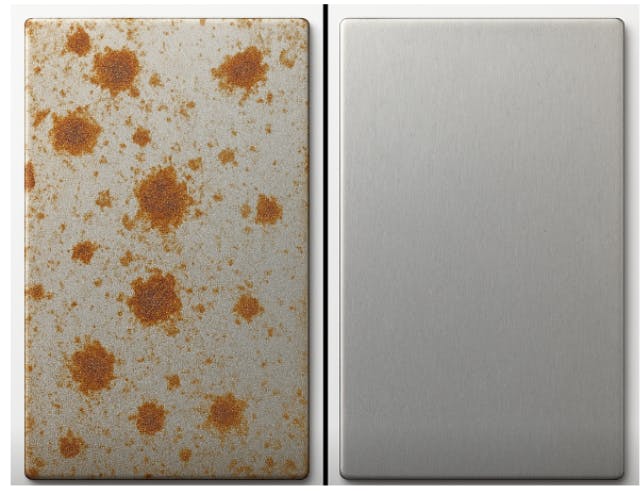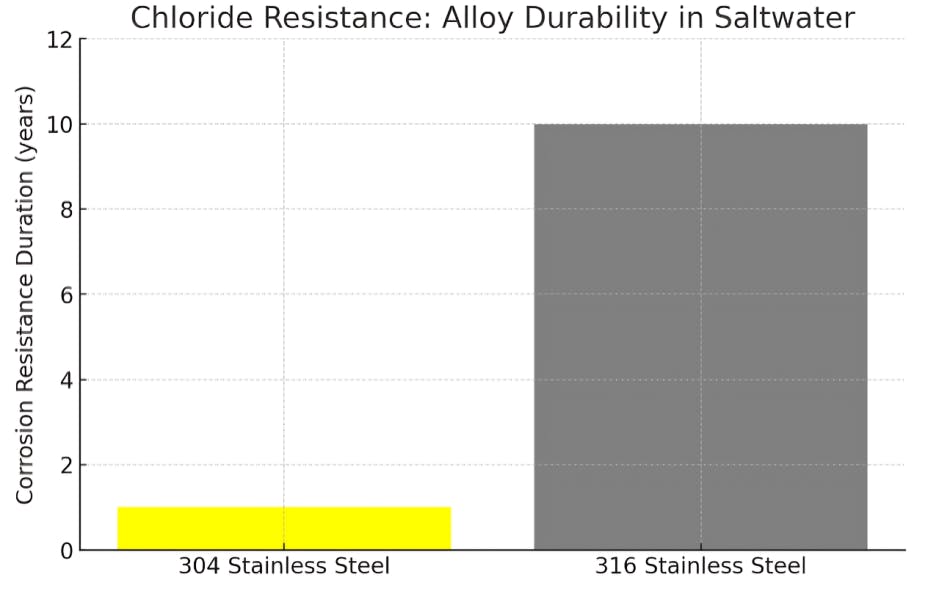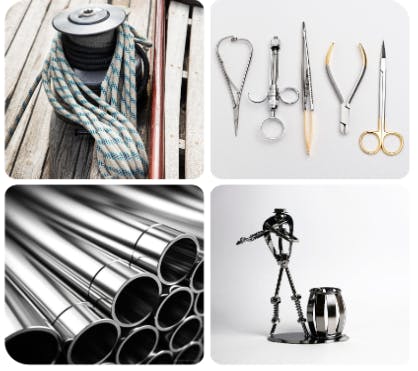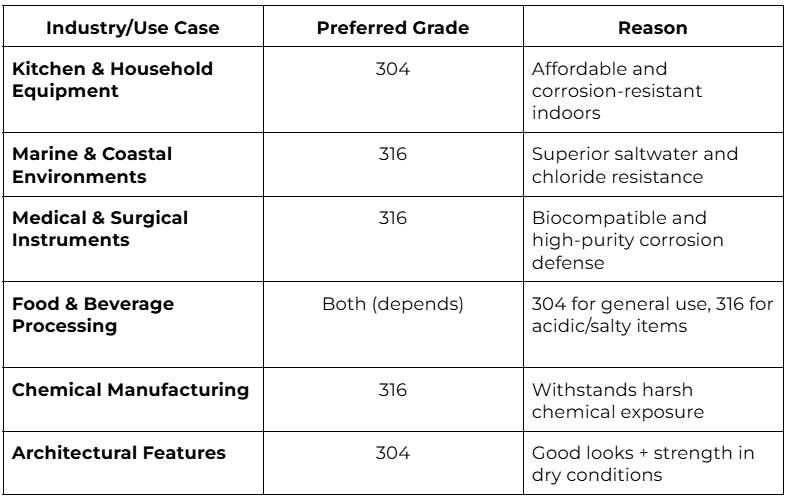304 vs 316 Stainless Steel: What’s the Difference and Which One Should You Choose?
Stainless steel is everywhere. From the sleek appliances in your kitchen to the rugged bolts holding together offshore oil rigs, this stainless steel material has become synonymous with strength, durability, and corrosion resistance. But not all stainless steel is created equal.
If you've ever found yourself wondering whether to go with 304 or 316 stainless steel, you're not alone-and you're asking the right question. While these two stainless steel grades may look nearly identical to the untrained eye, what’s hiding beneath the surface could make or break your next project.
So, what really sets them apart? Is it the price? The resistance to rust? Their performance in demanding environments?
In this article, we’ll cut through the confusion and deliver a clear, side-by-side comparison of 304 vs 316 stainless steel-covering their composition, properties, real-world applications, and of course, the all-important cost considerations.
Whether you're a product designer, engineer, procurement lead, or just stainless steel-curious, this guide will help you make the smartest material decision for your needs.
Let’s dive into the nitty-gritty.
Composition and Chemical Properties
At first glance, 304 and 316 stainless steels may seem interchangeable; they are both part of the austenitic stainless steel grades, share a similar appearance, and even have overlapping uses of stainless steel.
But the real distinction lies beneath the surface, in their chemical makeup.
The basics: What’s in the mix?
Both 304 and 316 stainless steels are iron-based alloys enhanced with chromium and nickel to give them their signature corrosion resistance and mechanical strength. However, the difference comes down to one critical element: molybdenum.
- 304 stainless steel contains chromium (18–20%) and nickel (8–10.5%), which gives it excellent general corrosion resistance.
- 316 stainless steel builds on that foundation with the addition of 2–3% molybdenum, significantly improving its resistance to chlorides, saltwater, and industrial chemicals.
That small percentage of molybdenum makes a big impact-and often determines which grade is suitable for more aggressive environments.

Quick takeaway: If your project is likely to encounter harsh chemicals, seawater, or salt spray, the molybdenum in 316 is your best friend. For more general indoor or mild outdoor applications, 304 is typically more than sufficient.
Mechanical Properties
While composition reveals what each grade is made of, mechanical properties tell us how they perform under stress-which is critical when choosing materials for manufacturing, construction, or high-load applications.
Both 304 and 316 stainless steels are known for their excellent mechanical performance, especially when compared to mild steel or ferritic stainless grades. However, subtle differences can guide engineers and designers toward the most efficient and durable choice for their projects.
Key mechanical properties compared

What does this mean for your project?
- Tensile and yield strength: Both grades offer solid performance, but 316 has a slight edge in ultimate tensile strength, making it more durable under sustained loading. That said, 304’s slightly higher yield strength means it resists deformation just a bit better at lower stress levels.
- Hardness: 316 is marginally harder, which can improve wear resistance in abrasive environments-but the difference is small and often not a deal-breaker.
- Ductility (Elongation): 304 has the upper hand in ductility, meaning it can stretch more before breaking. This makes it a solid choice for deep drawing, stamping, or forming operations, where flexibility matters.
Application-driven choices
- For components requiring deep forming or bending, 304 is often preferred due to its superior ductility.
- For mechanical parts exposed to heavy loads and wear, 316’s added tensile strength and hardness may offer longer life and better performance.
- In abrasive or slightly corrosive industrial environments, 316 can outperform 304 by maintaining its mechanical integrity even as it resists corrosion.
Corrosion Resistance
If there’s one area where 316 stainless steel truly shines, it’s here.
While both 304 and 316 stainless steels are highly resistant to rust and corrosion, the presence of molybdenum in 316 significantly boosts its performance in aggressive environments-especially those involving chlorides (like saltwater) and harsh chemicals.
A side-by-side comparison of 304 and 316 stainless steel in a salt-spray test:

304: General-purpose corrosion resistance
304 is no slouch-it offers excellent resistance to:
- Most oxidizing acids
- Everyday environmental conditions (humidity, rain)
- Food and beverage exposure
It performs well in indoor applications and mild outdoor environments, making it the go-to choice for:
- Kitchen appliances
- Food processing equipment
- Architectural features
- Storage tanks
Limitation: 304 is more vulnerable to pitting corrosion when exposed to chloride-rich environments (like seawater, road salts, or poolside applications).
316: Superior resistance in harsh conditions
Thanks to its 2–3% molybdenum content, 316 can stand up to:
- Saltwater and marine atmospheres
- Industrial chemicals (acids, chlorides, alkalis)
- Deicing salts and road chemicals
That makes 316 ideal for:
- Marine components (boat fittings, dock fasteners)
- Chemical processing equipment
- Outdoor enclosures in coastal or polluted areas
- Medical and pharmaceutical equipment (where contamination is a concern)
Bonus: 316 also resists crevice corrosion and stress corrosion cracking better than 304-key benefits in high-stress or submerged environments.
Quick decision tip
If your application never sees salt, chemicals, or harsh weather, 304 is a cost-effective and reliable option. If you’re dealing with marine, coastal, or industrial environments, don’t compromise-go with 316.

The chart compares the corrosion resistance of 304 and 316 stainless steel in a simulated saltwater environment, showing that 316 lasts significantly longer, with a resistance duration of 10 years compared to 304's 1 year.
Common Applications
Understanding where and why 304 or 316 stainless steel is used can help make the decision far easier. Each grade excels in different settings-not just based on cost, but also based on environmental exposure, hygiene standards, and structural requirements.
Let’s look at where each stainless steel grade is commonly used in the real world.
Applications of 304 stainless steel
Often referred to as the “workhorse” of stainless steel, 304 is used across countless industries thanks to its balance of strength, corrosion resistance, and affordability.
Common uses of stainless steel, like 304, include:
- Kitchen equipment: sinks, countertops, splashbacks, cutlery
- Food and beverage production: brewing vessels, milk tanks, storage silos
- Architectural and structural components: railings, balustrades, decorative panels
- Household hardware: doorknobs, brackets, bolts, and fasteners
- Automotive trim: especially in dry environments

For sheet metal fabrication, 304 stainless steel is a reliable choice due to its ease of welding and forming, making it a popular option for various applications.
Why 304? It's versatile, easy to fabricate, and offers solid corrosion resistance in typical indoor or low-exposure conditions.
Applications of 316 stainless steel
When performance under pressure (or in salt!) is non-negotiable, 316 stainless steel steps up. Thanks to its enhanced resistance to corrosion-especially from chlorides-it’s the top choice in marine, medical, and chemical environments.
Common uses of stainless steel, like 316, include:
- Marine components: boat fittings, dock hardware, propeller shafts
- Medical devices: surgical instruments, orthopedic implants
- Chemical processing equipment: tanks, valves, pipelines
- Pharmaceutical and food processing: cleanrooms, sanitary piping
- Outdoor structures: exposed fasteners, sculptures, enclosures in coastal or industrial zones
If you're looking to work with CNC machining materials that require higher corrosion resistance, 316 stainless steel is often the superior choice for industries exposed to harsh chemicals or saltwater.

Application Comparison Table

Cost Considerations
When it comes to choosing between 304 and 316 stainless steel, cost is often the deciding factor-especially for large-scale manufacturing, procurement, or product design decisions.
For example, for CNC machining applications, 316 stainless steel is a higher-end choice due to its durability and resistance, which can make it the better investment for projects that require long-term performance.
While both are relatively high-end materials compared to mild or carbon steel, 316 stainless steel consistently commands a higher price tag. But the question is: is that premium always justified?
Let’s break it down.
Why is 316 stainless steel more expensive?
The price difference between 304 and 316 primarily comes down to material composition:
- 316 contains 2–3% molybdenum, an alloying element that’s significantly more expensive than others.
- Higher nickel content in 316 (up to 14%) also contributes to the cost.
- Global fluctuations in commodity metal prices (especially nickel and molybdenum) impact the price spread between the two grades.
On average, 316 stainless steel costs 20–30% more than 304, though this can vary by market, form factor (sheet, bar, tube), and supplier.
Is the extra cost worth it?
It depends on your environment, if your product will be used in a saltwater, marine, or highly corrosive environment, the cost of corrosion failure-from replacement parts to safety risks-can far exceed the initial savings of going with 304.
In those scenarios, 316 is not just a better material; it’s a long-term investment.
However, for indoor, low-moisture, or decorative applications, 304 will perform admirably without the extra spend.
Cost vs. Performance: When to choose which

Other factors that affect total cost
- Fabrication: Both grades are easy to weld, cut, and form-but 316’s added hardness can slightly increase tooling wear and machining time.
- Availability: 304 is more widely stocked and available in more shapes/sizes, which can reduce procurement time and cost.
- Maintenance costs: While upfront costs may be lower with 304, long-term maintenance, replacement, or rust treatment could end up costing more if it’s used in the wrong environment.
Making The Right Choice Between 304 and 316 Stainless Steel
When it comes down to it, both 304 and 316 stainless steels are exceptional materials-each with their own strengths.
- If your project is indoors, in a low-corrosion environment, or you’re working with a tight budget, 304 is a smart, versatile, and cost-effective choice.
- If you’re dealing with saltwater, chemicals, or high-value components where failure is not an option, 316 offers that extra layer of protection and peace of mind.

Your choice should always be guided by the environment, the application, the lifecycle cost, and of course, how critical performance is to your bottom line.
Still Unsure? That’s Where Geomiq Comes In
At Geomiq, we don’t just deliver parts-we deliver certainty.
Whether you're prototyping a new product, scaling up production, or navigating complex material specifications, our network of vetted suppliers and our in-house engineering support are here to help you select the right material, optimise for cost and performance, and bring your ideas to life-faster.
Need help deciding between 304 and 316 for your project?
Reach out to our team today-we’ll connect you with experts who understand your application, your industry, and your goals.
About the author
Sam Al-Mukhtar
Mechanical Engineer, Founder and CEO of Geomiq
Mechanical Engineer, Founder and CEO of Geomiq, an online manufacturing platform for CNC Machining, 3D Printing, Injection Moulding and Sheet Metal fabrication. Our mission is to automate custom manufacturing, to deliver industry-leading service levels that enable engineers to innovate faster.